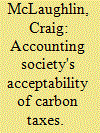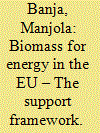|
|
|
Sort Order |
|
|
|
Items / Page
|
|
|
|
|
|
|
| Srl | Item |
| 1 |
ID:
166718


|
|
|
|
|
| Summary/Abstract |
This article seeks to examine accountants' perceptions of carbon taxes in addressing climate change. Specifically, it aims at (i) a better understanding of accountants opinions on carbon taxes; (ii) how energy companies have adapted their business operations since introducing carbon tax. The article's primary sources of data are (1) a 2018 survey distributed to 45 accounting professionals in Scotland, which specialise in energy finance and a formal interview with a regional finance director of a multinational energy company. The results show how the accountants are in favour the carbon tax due to its positive environmental impact, however, do not agree with the associated rising utility costs. Though, carbon tax, from an energy business' perspective, is viewed negatively due to its effects on the end users of energy. This study contributes to the current research by demonstrating the role of accounting society in boosting public awareness of climate change. The findings of this study will help regulators and policy makers in the UK to evaluate the adequacy of current carbon tax reforms and to promote the public awareness of climate change to reduce carbon emissions.
|
|
|
|
|
|
|
|
|
|
|
|
|
|
|
|
| 2 |
ID:
166717


|
|
|
|
|
| Summary/Abstract |
Heat decarbonisation is the biggest challenge facing UK energy policy. This paper presents an area-based modelling approach to heat electrification using 17,741 dwellings in the city of Newcastle upon Tyne as a case study. The presented framework has been developed so as to address local energy policy questions on the impact of domestic electrical heating options. These questions reflect significant under-researched challenges such as the quantification of peak electricity demand for heat pumps based electrification options. The presented results show that the electrification of heat at city-scale will have a substantial impact on the local electrical grid infrastructure and provide a first indication of what the potential additional mean and (winter) peak household electricity demand ranges (i.e. 59–95%. This is significantly lower than what might be ascertained from existing literature). Furthermore, the results show that emission savings will be achieved with all electrification options studied but achieving the city's ambitious decarbonisation goals will require more exploration of the urban energy landscape. The paper further underpins the significance of sub-city modelling by enabling policy makers to identify housing neighbourhoods at LV sub-station for area-based delivery. Finally, an integrated modelling approach to cope with forthcoming energy system design challenges at LV scale is suggested.
|
|
|
|
|
|
|
|
|
|
|
|
|
|
|
|
| 3 |
ID:
166714


|
|
|
|
|
| Summary/Abstract |
While access to cleaner fuel is a sustainable development goal, the transition from traditional to modern fuel is yet to be achieved in India. This paper estimates fuel costs associated with such transitions and analyses the determinants of access to electricity for lighting and Liquified Petroleum Gas (LPG) for cooking. State-level regression models based on data from 61st (2004–05), 68th (2011–12) and 71st (2014) rounds of National Sample Survey are used. While energy expenditures are found to be comparable for kerosene and electricity for lighting, it increases 3.6–8.8-fold for transition to LPG from traditional fuel. Availability is important for greater uptake of electricity i.e. higher rate of electrification helps, but the same is not true for LPG. While untargeted tariff-subsidy leads to significant budgetary pressure, it doesn't affect the access. States with higher income and literacy rate/women empowerment have greater access to LPG and electricity. This shows while Indian energy policies always focused on removal of supply-side barriers through infrastructure creation, removal of first cost barrier and subsidizing tariff, a more meaningful way to ensure access is perhaps to integrate energy policies within the broader arena of comprehensive development policies to ensure improvement in socio-economic indicators.
|
|
|
|
|
|
|
|
|
|
|
|
|
|
|
|
| 4 |
ID:
166706


|
|
|
|
|
| Summary/Abstract |
This paper aims to produce a quantitative approach on the overall measures and on public support framework for biomass for energy, based on the EU countries reports under RED and existing literature. The way in which the support for biomass is implemented in the EU energy sector is not similar across EU countries. Feed-in tariffs and feed-in-premiums are still the dominant support schemes for the deployment of bioelectricity, whereas subsidies remain the main support for bioheat. Furthermore, a vast number of EU countries apply mandatory blending quotas for biofuels for transport. The paper shows that biomass for energy has a key role within the EU policy support for RES, in which targets are the main drivers, together with overarching biomass guidelines to anticipate any environmental constraints. Stable support showed the highest effectiveness in the past and remains the key factor for biomass deployment beyond 2020. The renewed targets need to be accompanied by long-term support measures and a commonly shared policy vision. A further harmonization of public bioenergy support towards a single EU cleaner energy market is recommended. This implies four policy actions for all EU countries: in-depth efficiency review, integration with RED-2, compatible sustainability guidelines and local impact assessments.
|
|
|
|
|
|
|
|
|
|
|
|
|
|
|
|
| 5 |
ID:
166719


|
|
|
|
|
| Summary/Abstract |
Across the world, the electricity industry is changing with the advent of renewable energy sources such as solar and wind power. As these are exposed to intermittency, seasonality, and global-climate-variation, policy-makers' concerns are now shifting towards security of supply. In fact, the industry confronts three conflicting goals: security of supply, competitive prices to customers, and environmental protection. In this context, and given the multiple uncertainties of technology transformation, this paper uses modelling-based scenario analysis to investigate different extreme and plausible futures. Simulation is used to analyse policies aimed at increasing the penetration of renewables and to explore how these energy sources may affect system reliability. This paper explores the effect of incorporating renewables in Colombia, where a large hydroelectric component has led to insufficient electricity being available during droughts and to high electricity price volatility. Though not intuitive at first glance, this paper shows that renewables may contribute to: i) increased security of supply through complementarity, e.g., it does not rain when the sun shines; ii) reduced price volatility in the medium-term, and iii) increased industry sustainability.
|
|
|
|
|
|
|
|
|
|
|
|
|
|
|
|
| 6 |
ID:
166730


|
|
|
|
|
| Summary/Abstract |
Due to increasing demand for natural gas in Indonesia, the Government now promotes exploration for coalbed methane (CBM). Currently, Indonesia has 453 trillion cubic feet (TCF) of CBM reserves. However, CBM development in the country is still in the exploration phase, with significant under-investment. To attract investors, a tailored Production Sharing Contracts (PSC) regime is required. Based on a combination of Factor Analysis (FA), Discounted Cash Flows (DCF) and Parameter Sensitivity Analysis, the research explores an optimal scenario of a company's share of revenue that optimised CBM development contracts. We find that a combination of 5 years straight line depreciation (SLD), 5% First Tranche Petroleum (FTP), 78% Contractor Share (CS) and 35% income tax best spreads the risk of CBM development and exploitation between the government and the contractor. This combination is a more suitable PSC regime for developing CBM in an early stage of the industry. Therefore, the Government must cede some taxes during exploration to incentivise CBM development. Three PSCs regimes are thus required to fully develop and exploit CBM, including exploration, transitional and exploitation phase PSCs which better match contractor risks and returns and ensure reasonable certainty of contractor cost recovery.
|
|
|
|
|
|
|
|
|
|
|
|
|
|
|
|
| 7 |
ID:
166729


|
|
|
|
|
| Summary/Abstract |
Scientific evidence suggests earthquakes occurring in Oklahoma since 2009 are not “acts of God”, but very likely triggered by wastewater injection in disposal wells by oil and gas (O&G) companies. While sustaining the O&G industry's contribution to the economy is generally important, achieving environmental and public protection may in part rely on how earthquake inducers are held liable for damage. We use a Bayesian Tobit censored model, estimated using Markov Chain Monte Carlo (MCMC) methods to determine factors that influence public preferences for how much liability O&G companies should assume for induced earthquake-related damage. Data are from a survey of Oklahomans collected in 2017 by Survey Sampling International (SSI). Results suggest people would, on average, hold O&G companies liable for 75% of the earthquake damage. We find socio-demographic, earthquake, locational, and O&G industry-related factors as the main drivers of earthquake damage liability. However, their effects on damage liability vary between respondents that have had their property damaged by earthquakes and those that in some way benefit from O&G companies through jobs and gas-leases. We provide insights by which individuals might lobby representatives to impose new liability or regulatory mechanisms on O&G companies to avoid or compensate for earthquake damage.
|
|
|
|
|
|
|
|
|
|
|
|
|
|
|
|
| 8 |
ID:
166704


|
|
|
|
|
| Summary/Abstract |
Building energy efficiency standards (BEES) are believed to be one of the most effective policies to reduce building energy consumption, especially in the case of the rapid urbanization content in China. However, there is little evidence backed up by measured data to validate the actual effectiveness of BEES in China. Using survey data collected from 1128 households in Chongqing China, this study applied the propensity scores matching method to estimate the effect of two BEES levels: the 50%-BEES (low level) and the 65%-BEES (high level). Results show that buildings built with 65%-BEES, on average, can reduce cooling and heating electricity use intensity (kWh/m2/a) by 41%, compared to buildings in the absence of the BEES. Meanwhile, the adoption of 50%-BEES can reduce cooling and heating electricity use intensity (kWh/m2/a) by 38%. However, energy savings are not significant if comparing buildings with 65%-BEES and 50%-BEES. The results indicate that there exists a performance gap between calculated design performance savings and actual operation energy savings. These empirical findings provide policymakers with valuable feedback on buildings' actual performance. The findings suggest that it is necessary to incorporate outcome-based compliance pathways into the current BEES system. Lastly, a data-driven building policy evaluation mechanism should be developed in China. Energy consumption databases should be developed to support policies such as building energy codes and standards' development and performance evaluation.
|
|
|
|
|
|
|
|
|
|
|
|
|
|
|
|
| 9 |
ID:
166709


|
|
|
|
|
| Summary/Abstract |
The distributed nature of many renewable energy technologies allows for new ownership models as well as frequent ownership changes. We analyse whether a change in ownership negatively affects community attitudes toward a hypothetical small-scale hydropower plant. We use a two-stage framing experiment and a student sample. We find that a change in ownership has a significant negative effect on their attitudes toward the project, irrespective of whether the change is from a national to a local owner or vice versa. We interpret this finding as an example of a status quo bias, that is, a preference for the current state of affairs. A status quo bias makes renewable energy transitions more challenging, at least initially. Over time, as the status quo shifts, this may become less of an issue. We conclude the paper by discussing the robustness of our findings as well as whether and how policymakers can reduce the impact of such cognitive biases.
|
|
|
|
|
|
|
|
|
|
|
|
|
|
|
|
| 10 |
ID:
166700


|
|
|
|
|
| Summary/Abstract |
Using a three-round panel dataset of more than 3,000 households, the paper estimates the impacts of electricity reliability improvement on the welfare and economic decisions of rural Vietnamese households. The number of days without power outages in communes per annum is used to proxy for electricity reliability. We employ a fixed effect regression with an instrumental variable to deal with the endogeneity issue, led by the simultaneous causal relationship between the reliability of electricity and household outcomes along with the unobservable variables. We use the similar electricity quality variable but measured in other communes within the same province as an instrumental variable. Results from this model show that an improvement in electricity reliability plays an important role in enhancing incomes, durable consumption, access to credit and land investment decisions of rural households.
|
|
|
|
|
|
|
|
|
|
|
|
|
|
|
|
| 11 |
ID:
166723


|
|
|
|
|
| Summary/Abstract |
A number of official energy forecasts—including those compatible with the aspirational 1.5 °C Paris Accord global temperature rise limit—see both global primary and net energy use continuing to rise, even out to 2100. Various technologies, including greatly increased use of renewable and nuclear energy, negative emission technologies such as direct air capture, and geoengineering are proposed as approaches for meeting the 1.5 °C target. In contrast, we argue that meeting this target and avoiding significant increases in extreme weather events will require marked reductions in future energy demand. We argue that the combined fossil fuel and renewable net green energy production will fall in the coming decades, after subtraction of various energy costs essential for ecosystems maintenance, including those needed to stabilise climate. At best, nuclear energy will only fractionally increase its global energy share, because of its high capital costs and political opposition arising from accident risks, waste disposal and proliferation concerns. Geoengineering will not solve fossil fuel depletion, and has serious known—and perhaps unknown—risks. We conclude that global net energy produced in an ecologically sustainable manner will start falling in a decade or so, and suggest the need to account for this at a policy level by introduction of a green EROI—EROIg.
|
|
|
|
|
|
|
|
|
|
|
|
|
|
|
|
| 12 |
ID:
166735


|
|
|
|
|
| Summary/Abstract |
Our paper investigates the effect of wind and utility-scale solar electricity generation on wholesale electricity prices in Australia over 2010–2018. We use both high frequency (30-min) and daily datasets for the Australian National Electricity Market (NEM). We estimate autoregressive distributed lag models (ARDL) to decompose the merit order effect of wind and utility-scale solar PV generation over time and across states. We find that an extra GW of dispatched wind capacity decreases the wholesale electricity price by 11 AUD/MWh at the time of generation, while solar capacity by 14 AUD/MWh. The daily merit order effect is lower. We show that the wind merit order effect has been increasing as a function of dispatched wind capacity over time. Despite of this, wholesale electricity prices in Australia have been increasing, predominantly driven by the increase in natural gas prices. Our findings further strengthen the evidence of the merit order effect of renewable energy sources, with important implications for the current energy policy debate in Australia.
|
|
|
|
|
|
|
|
|
|
|
|
|
|
|
|
| 13 |
ID:
166726


|
|
|
|
|
| Summary/Abstract |
Energy efficiency has emerged as a key point in port industry because of different factors such as the adoption of stronger environmental regulations and the increasing pressure of the local community on the surrounding ports. As gathering operational data from port terminals can be difficult due to privacy, studies on emissions and energy efficiency of these terminals are scarce. The following research provides key information about the real energy consumption and CO2 emissions of one of the most relevant container terminals in the Mediterranean area, located in Valencia, Spain. The results show that yard terminal tractors and rubber tyred gantry cranes (RTGs) are the main emission sources, accounting for 68.1% of the terminal's total CO2 emissions. After identifying the equipment responsible for the environmental problem, two solutions aimed at improving the energy efficiency of the terminal have been studied: the retrofitting of RTGs cranes and the replacement of terminal tractors powered by fuel for a new liquefied natural gas tractor, which contributed to a large reduction of CO2 emissions. Additionally, the present research explores the different policies at the disposal of port authorities in order to foster the implementation of solutions aimed at mitigating the environmental externalities by terminal operators.
|
|
|
|
|
|
|
|
|
|
|
|
|
|
|
|
| 14 |
ID:
166727


|
|
|
|
|
| Summary/Abstract |
Increasing block pricing schemes represent difficulties for applied researchers who try to recover demand parameters, in particular, price and income elasticities. The Mexican residential electricity tariff structure is amongst the most intricate around the globe. In this paper, we estimate the residential electricity demand and use the corresponding structural parameter estimates to simulate an energy efficiency improvement scenario, as suggested by the Energy Transition Law of December 2015. The simulated program consists of a massive replacement of electric appliances (air conditioners, fans, refrigerators, washing machines, and lights) for more energy-efficient units. The main empirical findings are the following: in the main counterfactual scenario, the overall residential electricity consumption decreases 9.9% and the associated expenditure falls 11.3%. Additionally, the electricity subsidy decreases 7.5 billion of Mexican Pesos per year (i.e., 403 million of USD at the average exchange rate registered in 2017) and there is an annual cut in CO2 emissions of 3.9 million of tons.
|
|
|
|
|
|
|
|
|
|
|
|
|
|
|
|
| 15 |
ID:
166731


|
|
|
|
|
| Summary/Abstract |
Wind power represents a key component of Turkey's energy strategy. Increased investment will be required to meet Turkey's wind power target and, as such, there is a need to understand the viability of wind power projects there. The cost of capital is a crucial element in wind power investment decisions owing to the high capital intensity of wind power plants. A reduction in the cost of capital through support policies can lower overall project costs and increase investment. We estimate the cost of capital for wind power projects in Turkey using data on 138 installations that participated in the Turkish feed-in tariff scheme in 2017. Our estimates indicate an upper bound of 12% for the cost of capital. This suggests the cost of capital for wind power projects in Turkey is not higher than in south-eastern European Union countries. However, because of adverse macroeconomic conditions, the cost of Turkey's main renewable support scheme increased by 46% between 2016 and 2017 in Turkish lira terms. We argue that continued commitment to the current support schemes by the Turkish authorities is crucial for the development of the Turkish wind power sector.
|
|
|
|
|
|
|
|
|
|
|
|
|
|
|
|
| 16 |
ID:
166712


|
|
|
|
|
| Summary/Abstract |
Abundant research has focused on the public acceptance of renewable energy sources (RES) since their successful implementation is often dependent on the public. Yet, little is known about the attitudes of university students towards RES whose study field is related to the environment, even though the mindset of these students is considered relevant since they are possible experts in the RES field. To contribute to this neglected research strand, this paper aims to explore the awareness about and attitudes towards RES of students majoring in the Department of Forestry and Management of the Environment and Natural Resources at the Democritus University of Thrace in Greece. Results based on quantitative data collected via questionnaire show that the surveyed students support renewables and have awareness about the current polluting energy system. Moreover, they have positive environmental attitudes and fully recognize the need for energy transition. Finally, there are significant differences among students from different years of study, highlighting that fourth- and fifth-year students take greater interest in working in the RES sector after they complete their studies.
|
|
|
|
|
|
|
|
|
|
|
|
|
|
|
|
| 17 |
ID:
166710


|
|
|
|
|
| Summary/Abstract |
Evidence and conventional wisdom suggest that general poverty has a negative effect on the well-being of individuals. However, the mechanisms through which this effect occurs are not well-understood through economic approach. In this paper, we analyse the influence of general and fuel poverty as well as the social dimension through peer comparison on the subjective well-being of households. We develop a novel approach to analyse fuel poverty and well-being based on consumer theory. Individual preferences are modelled using indifference curves and a distance function where the preferences of individuals are affected by their poverty status. We use the survey data from the official Spanish Life Condition Survey for 2013, which contains over 16,608 observations on household members. The results show that both general and fuel poverty influence the reference indifference curve but that individuals also compare themselves with their peers. The proposed model also allows us to corroborate how general and fuel poverty affect well-being and how effective policies can be designed to improve social welfare.
|
|
|
|
|
|
|
|
|
|
|
|
|
|
|
|
| 18 |
ID:
166701


|
|
|
|
|
| Summary/Abstract |
In the absence of sufficient coverage of metering data on the electricity consumption of individual devices, this paper estimates the contribution of individual appliances to overall household electricity consumption, drawing on the most recent wave of the German Residential Energy Consumption Survey (GRECS). Moving beyond the standard focus of estimating mean effects, we combine the conditional demand approach with quantile regression methods to capture the heterogeneity in electricity consumption rates of individual appliances. Our results indicate substantial differences in these rates, as well as the end-use shares across households originating from the opposite tails of the electricity consumption distribution. This outcome highlights the added value of applying quantile regression methods in estimating consumption rates of electric appliances and indicates some scope for realizing conservation potentials.
|
|
|
|
|
|
|
|
|
|
|
|
|
|
|
|
| 19 |
ID:
166720


|
|
|
|
|
| Summary/Abstract |
Traditional cooking is today's largest global environmental health risk. Over 640 million people in Africa are expected to rely on biomass for cooking by 2040. In Kenya, cooking inefficiently with wood and charcoal persists as a cause of deforestation and household air pollution. This research analyses the effects of four biomass cookstove strategies on reducing air pollutant emissions in Kisumu County between 2015 and 2035 using the Long-Range Energy Alternatives Planning system. The Business as Usual scenario (BAU) was developed considering the historical trends in household energy use. Energy transition scenarios to Improved Cookstoves (ICS), Pellet Gasifier Stoves (PGS) and Biogas Stoves (BGS) were applied to examine the impact of these systems on energy savings and air pollution mitigation. An integrated scenario (INT) was evaluated as a mix of the ICS, PGS and BGS. The highest energy savings, in relation to the BAU, are achieved in the BGS (30.9%), followed by the INT (23.5%), PGS (19.4%) and ICS (9.2%). The BGS offers the highest reduction in the GHG (37.6%), CH4 (94.3%), NMVOCs (85.0%), CO (97.4%), PM2.5 (64.7%) and BC (48.4%) emissions, and the PGS the highest reduction in the N2O (83.0%) and NOx (90.7%) emissions, in relation to the BAU.
|
|
|
|
|
|
|
|
|
|
|
|
|
|
|
|
| 20 |
ID:
166716


|
|
|
|
|
| Summary/Abstract |
To promote the level of electrification, reduce environmental pollution, and achieve the goal of clean energy usage and green economic growth in China, the National Development and Reform Commission and other eight departments jointly issued and implemented the Policy of Electricity Substitution in 2016. Electricity substitution aims to replace traditional fossil fuels such as coal and fuel oil with clean electric energy in different fields, e.g., industry, transportation, and construction, and deal with the pollutants at power generation. However, we still need to find out the exact impact of the Policy of Electricity Substitution on energy saving and emission reduction. In this paper, we estimate the economically feasible increment of electricity demand according to different classifications in electricity substitution technology. Furthermore, based on the Input-Output model, we discuss the relative influence of the Policy of lectricity Substitution. The main conclusions are: First, the Policy of Electricity Substitution alone is not adequate to reduce the dependence on fossil energy and environmental pollution under China's current power generation structure, we should also increase the use of renewable energy. Second, the power sector plays a leading role in stimulating economic output, and the increasing electricity consumption due to the Policy of Electricity Substitution can boost the green development of China's economy.
|
|
|
|
|
|
|
|
|
|
|
|
|
|
|
|
|
|
|
|
|